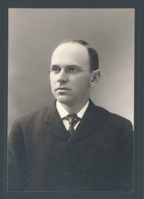Elliott P. Joslin
Elliott Proctor Joslin (born June 6, 1869 in Oxford , Massachusetts , † January 28, 1962 in Brookline , Massachusetts) was the first diabetologist in the United States and founder of today's Joslin Diabetes Center . He was one of the first to discover the connection between regular blood sugar checks and a lower frequency of complications in diabetes.
Life
Elliot P. Joslin was born in Oxford, Massachusetts in 1869. He completed his training at Leicester Academy , Yale College and Harvard Medical School .
Joslin first turned to diabetes when his aunt was diagnosed with the disease while at Yale. At that time, diabetes was still a largely unexplored disease for which there was no cure and only a slim chance of survival. It was for this reason that Joslin specialized in diabetes at Harvard Medical School and won the Boylston Society Prize for his work, which was later published as The Pathology of Diabetes Mellitus .
He continued his postgraduate education at Massachusetts General Hospital, where he worked with leading metabolic specialists from Germany and Austria, among others. In 1898 he opened his own practice in the Back Bay area of Boston . In 1912 he was elected to the American Academy of Arts and Sciences and in 1925 to the American Philosophical Society . In 1932 he received the Kober Medal .
Services
In 1908 Joslin, together with the physiologist Francis G. Benedict, carried out an intensive metabolic study on patients who were all suffering from diabetes to varying degrees. They looked at how periods of fasting and eating affected patients. The results of the study later helped diabetologist Frederick Madison Allen evaluate his study on the effects of a low-carbohydrate, low-calorie diet. The patients were referred to New England Deaconess Hospital , which started a program to help nurses help patients follow their strict diet .
Joslin used the results of a thousand of his own cases in his 1916 monograph, The Treatment of Diabetes Mellitus , in which he observed a twenty percent lower mortality rate in patients who adhered to a strict meal and exercise schedule. During Joslin's lifetime there were more than ten editions of this book, which ultimately helped to consolidate his reputation as the world's leading diabetologist.
Two years later, Dr. Joslin published the book Diabetic Manual - for the Doctor and Patient , in which he described in detail which measures those affected can take themselves to better manage their disease. It was the first manual for diabetics and became a bestseller. To date, fourteen editions of this pioneering work have been published, which is currently being published in the Joslin Diabetes Center under the title The Joslin Guide to Diabetes .
When insulin therapy became available to everyone in 1922 , Joslin's team of nurses pioneered today's certified diabetes advisors, who gave patients advice on diet, exercise, foot care, and insulin dosage. He also set up summer camps for children with diabetes all over New England (USA).
Joslin always used multidisciplinary approaches. He worked with nurses in the field of training and with surgeons and podiatrists in the treatment of diseased limbs . He consulted pathologists in describing complications and obstetricians in assessing the risks to the newborn from gestational diabetes . The first pre-meal test blood glucose meters in hospitals were developed under his supervision in 1940. They were the forerunners of modern patient measuring devices.
Joslin was also the first to classify diabetes as a widespread disease to be taken seriously. Shortly after the end of World War II, he raised concerns with the Surgeon General of the United States Public Health Service that diabetes was already epidemic and called on the government to conduct a study in his hometown of Oxford, Massachusetts. This finally began in 1946 and was carried out over a period of twenty years. The results later confirmed Joslin's fears that the number of people suffering from diabetes was reaching the proportions of an epidemic. Together with Frederick Madison Allen, he is now regarded as one of the leading diabetologists of the period from 1910 to 1920.
In 1952, Joslin's group practice was officially known as the Joslin Clinic , and in 1956 the main office moved to its current location at One Joslin Place in Boston. The Joslin Clinic was the first special facility for diabetes and is still the largest diabetes clinic in the world today.
For Joslin, it was clear that complications caused by diabetes could be avoided through a low-carbohydrate diet, exercise and regular insulin regulation. The American Diabetes Association has been divided over its correctness since the creation of this thesis, and endocrinologists and other scientists have argued about it for decades. It wasn't until thirty years after his death in 1993 that Joslin's thesis was confirmed by a ten-year study entitled The Diabetes Control and Complications Trial Report (DCCT). It appeared in the highly respected New England Journal of Medicine and showed that strict blood sugar control can prevent complications from diabetes - a theory Joslin had defended decades earlier.
Joslin died in his sleep on January 29, 1962 in Brookline, Massachusetts .
Individual evidence
- ^ Member History: Elliot P. Joslin. American Philosophical Society, accessed October 15, 2018 .
| personal data | |
|---|---|
| SURNAME | Joslin, Elliott P. |
| ALTERNATIVE NAMES | Joslin, Elliott Proctor (full name) |
| BRIEF DESCRIPTION | American diabetologist |
| DATE OF BIRTH | June 6, 1869 |
| PLACE OF BIRTH | Oxford (Massachusetts) |
| DATE OF DEATH | January 28, 1962 |
| Place of death | Brookline (Massachusetts) |
